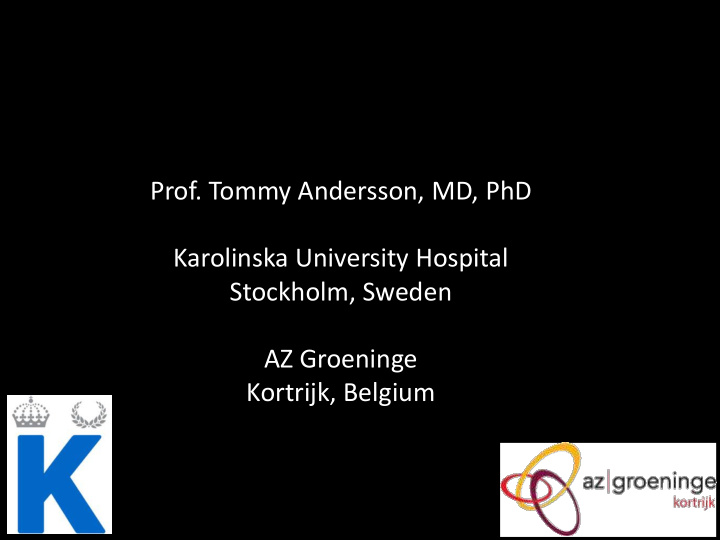



Prof. Tommy Andersson, MD, PhD Karolinska University Hospital Stockholm, Sweden AZ Groeninge Kortrijk, Belgium
Disclosures TA Consultant: • Ablynx • Amnis Therapeutics • Codman • Medtronic • Neuravi • Rapid Medical • Stryker
Case 1: 53 yo female • Other country: sudden headache, nausea, LOC • Did not seek medical attention – travel • 5d later, still headache, no focal deficit • Admitted to Karolinska • CT and CTA
CT and CTA • SAH – bilateral blood in Sylvian fissure + LVs and 4th ventr – Fisher gr 4 • Hydrocephalus • Bilobular AcomA aneurysm, 6 x 4 x 3 mm • No A1 left
Decided to coil • GCS 4 + 6 + 4 = 14 – no EVD • Hunt & Hess = 2 • WFNS = 2 • Heparin • 7F 80 cm Arrow sheath • 7F Guider Soft-tip • MC SL-10 • Microplex Cosmos and Hypersoft • Prepared for balloon, not used – risk for vasospasm
1st coil 2nd coil – small rupture 2nd coil – small rupture Final 4 th coil 3rd coil
10 mg Nicardepine was given after coiling due to vasospasm
Post procedure • Reasonably good result • XperCT showed some blood/contrast in interhemispheric fissure as expected • Circulatory stable • Pt went back to Neuro-ICU still intubated
3-4 hours later • Called from N-ICU: difficult to extubate, extension pattern, sunset • GCS 3-4! • CT at N-ICU (8-slice): blood interhemispheric fissure, ambient cistern, large hypodens bicortical areas, compressed gyri! • Signs of global ischemia confirmed on regular CT
CTA • Slight to moderate vasospasm – mainly left MCA
Clinical course • EVD considered but declined • Pt remained GCS = 3 • 3 days later aortocervical angio revealed no remaining intracerebral circulation – pt declared dead
Discussion – explanation? • Allergy against Nicardepine? • Peripheral vasospasm? • Hypotension during coiling – ICP > MAP! – Systolic BP 90-100 – Too low perfusion pressure (CPP) – Combination of hypotension, aggravated by nicardepine, and hydrocephalus with increased ICP, aggravated by small bleed, and some vasospasm
What can be learned • Always use balloon when coiling ruptured aneurysms? • EVD for monitoring and for the possibilty of CSF diversion? • Keep BP higher in pts treated late after bleed?
Recommend
More recommend